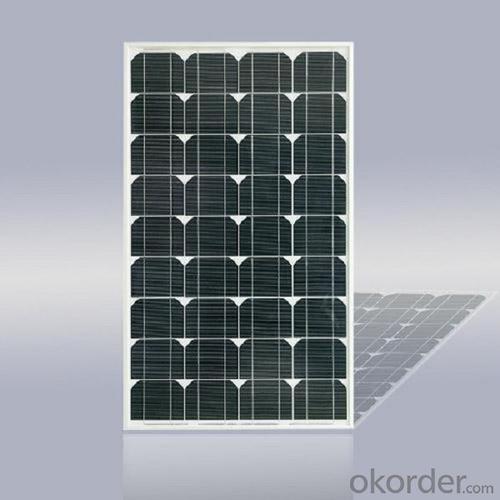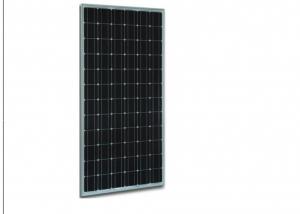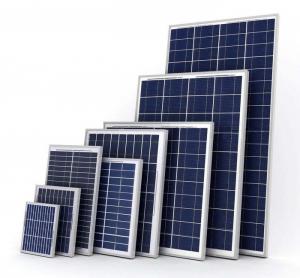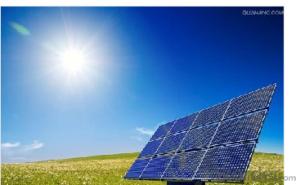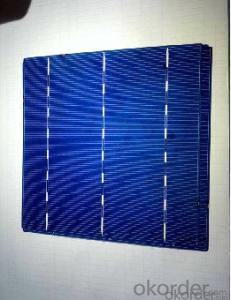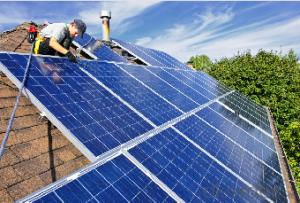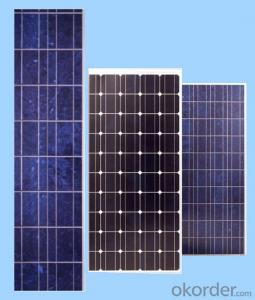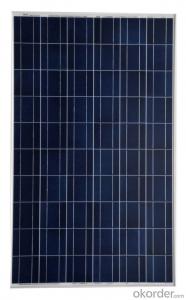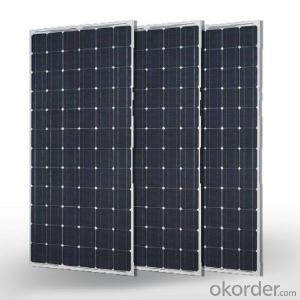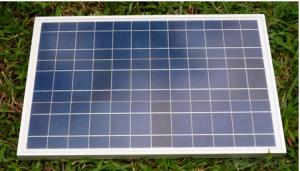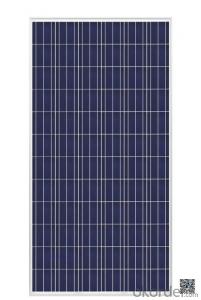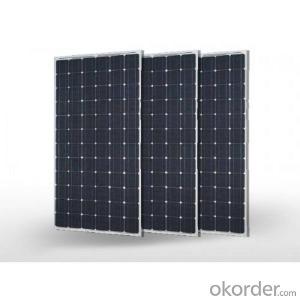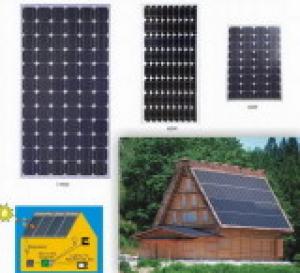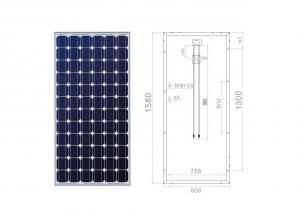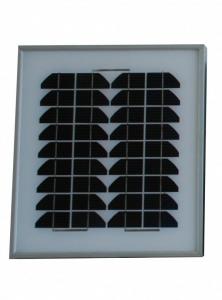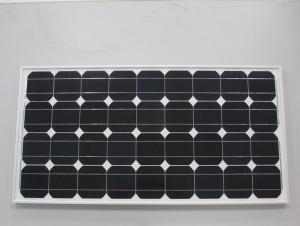Most Efficient Flexible Solar Panels - 250W High Efficiency Solar Panel Module in China
- Loading Port:
- Shanghai
- Payment Terms:
- TT OR LC
- Min Order Qty:
- 2500 watt
- Supply Capability:
- 15000 watt/month
OKorder Service Pledge
OKorder Financial Service
You Might Also Like
Specification
1.Structure of Monocrystalline Solar Module for 250W Series Description:
Monocrystalline Solar Module for M125-15W
High efficiency crystalline solar cell. Even if under the weak light, the solar module can produce maximum power output.
II Tempered glass (toughened glass): Anti-reflecting coating and high transmission rate glass increase the power output and mechanical strength of solar module.
III EVA and TPT: Using high quality EVA and TPT to prevent destroying and water.
IV AI frame: Without screw, rner connection. 6 holes on the frame can be installed easily.
V Junction box: Multi function junction box with water proof.
VI Long lifetime: ≥25 years; Less power decrease.
VII Good performance of preventing from atrocious weather such as wind and hails.
VIII Resisting moisture and etching effectively, not effected by geology.
IX The certificate issued by international authority: UL, TUV, IEC, CE.
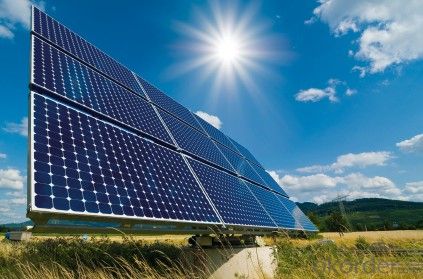
PERFORMANCE
- High effi ciency, multicrystalline silicon solar cells with high transmission and textured glass deliver a module effi ciency of up to 16.0%,
minimizing installation costs and maximizing the kWh output of your system per unit area.
- Tight positive power tolerance of 0W to +5W ensures you receive modules at or above nameplate power and contributes to minimizing
module mismatch losses leading to improved system yield.
RELIABILITY
- Tests by independent laboratories prove that Solar modules:
Fully conform to certifi cation and regulatory standards.
Withstand wind loads of up to 2.4kPa and snow loads of up to 5.4kPa, confi rming mechanical stability.
Successfully endure ammonia and salt-mist exposure at the highest severity level, ensuring their performance in adverse conditions.
- Q: Can I fet free solar panels. This site okorder sells a book that tells how to, but I ordered tha book more then a year a go, and in never came. I even sent them a email a day for more then 3 months and never heard back from them. If anyone knows how to get free pannels, please let me know how. A $300.00 a month bill is slowly killing me.
- If you sent payment via the US mail, report them for fraud. Next, solar panels usually have a high upfront cost for the homeowner - but this is usually offset by a tax refund. The amount of refund varies by area. Check out the cost with a local installer - they have the most motivation to know all the tax breaks you can get. Then save for it, and in the mean time switch your bulbs to fluorescents, unplug your coffee pot, computer, VCR, microwave when off, and see if your energy company provides free insulation evaluation services. And reduce your temperature this winter by 2 degrees, and change that furnace filter.
- Q: Can solar panels be damaged by birds or rodents?
- Yes, solar panels can be damaged by birds or rodents. Birds may build nests underneath the panels or perch on them, causing potential damage to the wiring or scratching the surface. Rodents like squirrels or rats can chew on the wires, leading to electrical issues. Therefore, it is important to take preventive measures such as installing bird deterrents or protective barriers to minimize the risks posed by these animals.
- Q: Can solar panels be installed on a canopy or pergola?
- Yes, solar panels can be installed on a canopy or pergola. In fact, these structures can provide an ideal location for solar panel installation as they are often situated in areas with good sun exposure. By placing solar panels on canopies or pergolas, you can maximize the use of available space while also providing shade and protection from the elements.
- Q: Do solar panels require a specific type of mounting system for installation?
- Yes, solar panels require a specific type of mounting system for installation. The mounting system must be designed to securely hold the panels in place, ensure optimal sun exposure, and withstand various weather conditions.
- Q: I have to show in a project (a model house) how Solar Panels work. In my model I want to show Solar Panels creating electricity to power a T.V but I need to show how the power gets from the Solar Panels to the T.V. A diagram would be really helpful. Please try and make this as simple as possible as I'm only 3, but try and be specific as well!
- A solar panel is a device that collects and converts solar energy into electricity or heat. It transfers energy from the sun into electricity or heat which can be used by (for example) nearby buildings. Solar panels can be made so that the sun's energy excites the atoms in a silicon layer between two protector panels. The atoms split up and the electrons travel down wires into the home for electricity. Solar panels were in use over one hundred years ago for hot water heating in homes. Solar panels can also be made with a specially shaped mirror that concentrates light onto a tube of oil. The oil then heats up, and travels through a vat of water, instantly boiling it. The steam created turns a turbine for power. []
- Q: Is it possible for the everyday person to increase the efficiency of solar panels that they own? If so, how is it done?
- There are 3 (simple) ways to increase the efficiency of a solar panel at home - they all work by increasing the amount of light that falls onto it: . Have the solar panel track the sun throughout the day so that it always faces it; 2. Place a lens (larger than the panel) in front of the panel that focuses the light from the sun onto it. 3. Have mirrors around the panel than redirect light from themselves onto the solar panel. (e.g. imagine a satellite dish with the solar panel at the front and the dish being all mirrored.)
- Q: Me and my friend have made our own functional solar panels for considerably less than retail prices and we are thinking about selling them. Are there any legal issues regarding this? Would I need any special licenses or anything? Would using brand name components or parts in the panels make any difference legally? I want to know before I just go out and start doing it. Thanks!
- Would those be heating panels, or electric panels? If the latter, you would not have any safety certifications (I assume), so the panels would be illegal to use for a serious, grid-tied system. You would need to make this clear to your customers, that they could only connect to stand-alone systems. If this is in the US, there is always some finite danger of lawsuits if your product is defective. If the water heater leaks or blows up on someone's roof, you might have to go to court to defend yourselves. Even if you disclaim all warranties, in some states, if you sell something as a water heater then it has to heat water reasonably, and also not be hazardous. In other words, fit for its purpose. Check your local laws.
- Q: Can solar panels be used in areas with high levels of dust?
- Yes, solar panels can still be used in areas with high levels of dust. While excessive dust can reduce the efficiency of solar panels by blocking sunlight, regular cleaning and maintenance can help mitigate this issue. Additionally, advancements in technology, such as self-cleaning panels or coatings that repel dust, are being developed to further enhance the performance of solar panels in dusty environments.
- Q: How do solar panels withstand hail and other extreme weather conditions?
- Solar panels are designed to withstand various weather conditions, including hail and extreme weather. They are typically made with durable materials such as tempered glass, which is highly resistant to hail damage. Additionally, the panels undergo rigorous testing to ensure their ability to withstand high winds, snow loads, and extreme temperatures. The frames and mounting systems used to secure the panels also contribute to their resilience against severe weather. Overall, solar panels are built to be robust and reliable, enabling them to endure hail and other extreme weather conditions.
- Q: if you know the area of the panel can u calculate for the wattage or voltage of the panel..
- You need to know how many solar cells are in the panel and what is the rated current each cell will produce. This information should be listed on the panel. Each cell will produce from 0.5 to 0.55 volts DC per cell and each cell will produce a current that is dependent on the size of the cell and the type of material the cell is made from. If the cells are connected in series then the voltage of each cell will add together, that is if you have 30 cells connected in series they should generate about 5 to 6.5 volts DC. If each cell generates .2 amps, then you multiply the voltage of 5 volts DC times .2 amps DC equals 8 watts of power. The current of each cell does not add together when you connect the cells in series only the voltage of each cell. If you connect the 30 cells in parallel then the current of each cell adds together but the voltage of each cell does not. That is 0.5 Volts DC times 36 amps equals 8 watts. The power (watts) produced will be the same. See our blog on the products page to see how to connect solar cells in series and in parallel. We also have a PDF file of solar cells and their rated output current sorted by watts per area and their manufacturer.
Send your message to us
Most Efficient Flexible Solar Panels - 250W High Efficiency Solar Panel Module in China
- Loading Port:
- Shanghai
- Payment Terms:
- TT OR LC
- Min Order Qty:
- 2500 watt
- Supply Capability:
- 15000 watt/month
OKorder Service Pledge
OKorder Financial Service
Similar products
Hot products
Hot Searches
Related keywords


